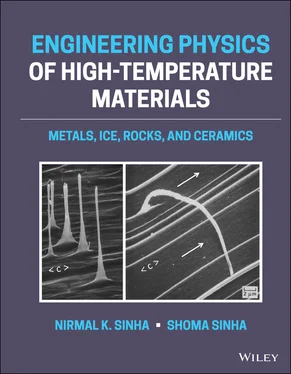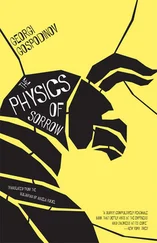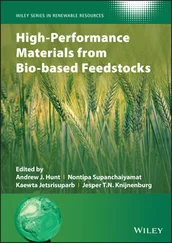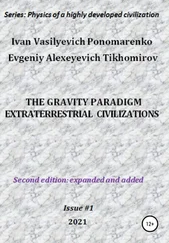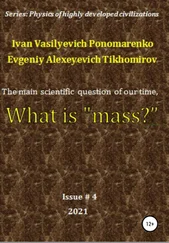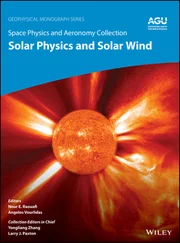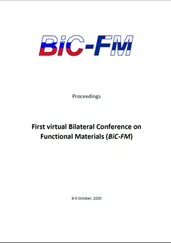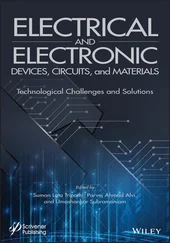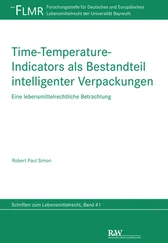A gamma double prime (γ″), often with the composition of Ni3Nb or Ni3V, can form small disk‐like precipitates with a GCP body‐centered tetragonal structure. These precipitates form with the (001) planes of the precipitate (γ″) parallel to the {001} family in the matrix (γ) as a result of lattice mismatch. They can strengthen the superalloy at lower temperatures compared to the γ′ phase, but often dissolve at higher temperatures. Figure 2.16 Schematic of cuboidal γ′ (Ni3(Al,Ti)) precipitates within a γ [FCC‐structured Ni, Co, and Fe solid solution]. In this schematic, the characteristic precipitate size is shown as dγ′.Sources: Betteridge and Heslop (1974); Ross and Sims (1987).
In addition to GCP phases, several phases can form, and many of these can be undesirable due to poor mechanical properties, incoherency with the matrix, and morphologies, such as needle‐like structures that can nucleate cracks as well as depleting the materials ability to form the desired γ′ particles (Belan 2016).
Carbide phases are also formed from carbon and reactive and refractory elements, such as titanium, tantalum, and hafnium (e.g. TiC, TaC, or HfC). With heat treatment (and/or service), the carbides can decompose to lower metal carbides, such as M23C6 and M6C, and often aggregate to the grain boundaries. Many carbides have an FCC structure and are known to support strengthening at grain boundaries in polycrystalline materials (Sabol 1969). However, their role in single crystal material properties is still under debate (Bowman 2000).
Cr and Al in the systems can also protect against oxidation and corrosion by forming protective oxide phases.
The addition of other elements can further tailor the properties of the alloy. For example, not only does higher Al and Ti result in higher volume fractions of the γ′‐phase, but also the addition of cobalt reduces the solubility of Al and Ti in the NiCr matrix and further promotes precipitation. This improves strength at high temperatures, as well as the workability of these alloys. Other elements are added to improve microstructural stability, strength, and deformation characteristics. The creep‐rupture life of these alloys can be increased significantly by the careful control of composition and microstructure. For different uses, variations in composition and process are critical leading to a variety of different nickel‐base superalloys in use. An example of the chemical compositions of some well‐known nickel‐base alloys is given in Table 2.2.
Table 2.2 Nominal chemical compositions (wt. %) of Nimonic 90 (Betteridge and Heslop 1974), IN‐738LC and René 80 (Balikci and Raman 2000; ASMH 1991), Waspaloy (ASMH 1991), and CMSX‐10 (Erickson 1996).
Sources: Betteridge and Heslop (1974), Balikci and Raman (2000), ASMH (1991), Erickson (1996).
| Element |
Nimonic 90 |
IN‐738LC |
René 80 |
Waspaloy |
CMSX‐10 |
| Ni |
≈54.6 (balance) |
≈61.2 (balance) |
≈60 (balance) |
≈58.3 (balance) |
≈69.3 (balance) |
| Cr |
19.6 |
16 |
14 |
19.5 |
2 |
| Co |
18 |
8.5 |
9.5 |
13.5 |
3 |
| Al |
1.4 |
3.5 |
3 |
1.3 |
5.7 |
| Ti |
2.35 |
3.5 |
5 |
3 |
0.2 |
| W |
— |
2.6 |
4 |
— |
5 |
| Mo |
0.3 |
1.8 |
4 |
4.3 |
0.4 |
| Ta |
— |
1.7 |
0.05 |
— |
8 |
| C |
0.09 |
0.1 |
0.17 |
0.08 |
— |
| Fe |
1 |
0.1 |
0.18 |
— |
— |
| B |
0.003 |
0.01 |
0.1 |
0.006 |
— |
| Zr |
0.07 |
0.1 |
0.06 |
0.06 |
— |
| Nb |
— |
0.9 |
— |
— |
0.1 |
| Si |
1.5 |
Trace |
Trace |
— |
— |
| Cu |
0.2 |
— |
— |
— |
— |
| Mn |
1 |
Trace |
Trace |
— |
— |
| Re |
— |
— |
— |
— |
6 |
| Hf |
— |
— |
— |
— |
0.3 |
Due to economic and environmental demands, the efficiencies of gas turbine engines have been steadily and systematically increased by design modifications, such as air cooling of components, to handle higher turbine inlet to firing temperatures. The gas turbine engines of today are more energy efficient and more reliable, as well as have cleaner burning capabilities, than their predecessors. The increase in operating temperatures, however, has led to the decrease in the life of components and increase in costs of replacement. This is serious because the technologies are becoming obsolete in a very short time, while the world's commercial fleet of aircraft or utilities is getting older. Around 80% of the large frame industrial/utility gas turbines operating in the world today were installed in the mid‐1960s to early 1970s, and they are now old and getting replaced. Consequently, there are now greater opportunities to repair and refurbish older models (Natole 1995; Valenti 1999). It is estimated that 50–70% of the operating and maintenance cost is due to the repair and/or replacement of hot section components made of nickel‐base superalloys. Repair or replacement of damaged engine components is not therefore a question of academic importance.

Figure 2.17 Dependence of strain age cracking susceptibility based “weldability” on the contents of aluminum and titanium. A general increasing trend for γ′ solvus temperature of the alloys is also shown; chemical compositions for alloys shown as solid points are given in Table 2.2.
Source: N. K. Sinha.
The repairability of a superalloy component is determined by a number of factors, such as chemical composition, grain size, grain‐boundary characteristic, substructural details of the matrix, prior heat treatment, history of service life, welding parameters, and welding processes. A full understanding of the interrelationship between the material characteristics, welding parameters, and the performance of the welded junctions requires knowledge of the physical chemistry of the parent and the filler materials involved.
The same features that improve high‐temperature performance of nickel‐base superalloys also make them vulnerable to structural degradation, such as coarsening of the γ′ precipitates and the oxidation of nickel and carbon producing subsurface grain‐boundary defects during service life, and also make them difficult to repair by welding (Jones and Westerman 1965; Thamburaj et al. 1983). Liquidation zone cracks (LZC) and heat‐affected zone (HAZ) cracks develop due to thermal stresses generated by volumetric changes associated with the dissolution and reprecipitation of γ′‐phase during welding (Thamburaj et al. 1983). The propensity for weld induced cracking (both LZC and HAZ) increases as the concentration of γ′ forming elements, such as aluminum and titanium, increases in the alloy, and hence as the volume fraction of γ′ increases. Figure 2.17shows a few commonly used nickel‐base superalloys along with the demarcation line (dashed) proposed by Prager and Shira (1968) to differentiate between weldable and nonweldable alloys. They examined the weldability on the basis of strain age cracking susceptibility. Most of the popular “polycrystalline superalloys” being used today were introduced between 1960 and 1985 (Stephens 1989), but observations confirm that alloys containing more than about 4 wt.% total content of Ti and Al are in general difficult to weld (Ikawa et al. 1974; Kelly 1990).
Читать дальше
